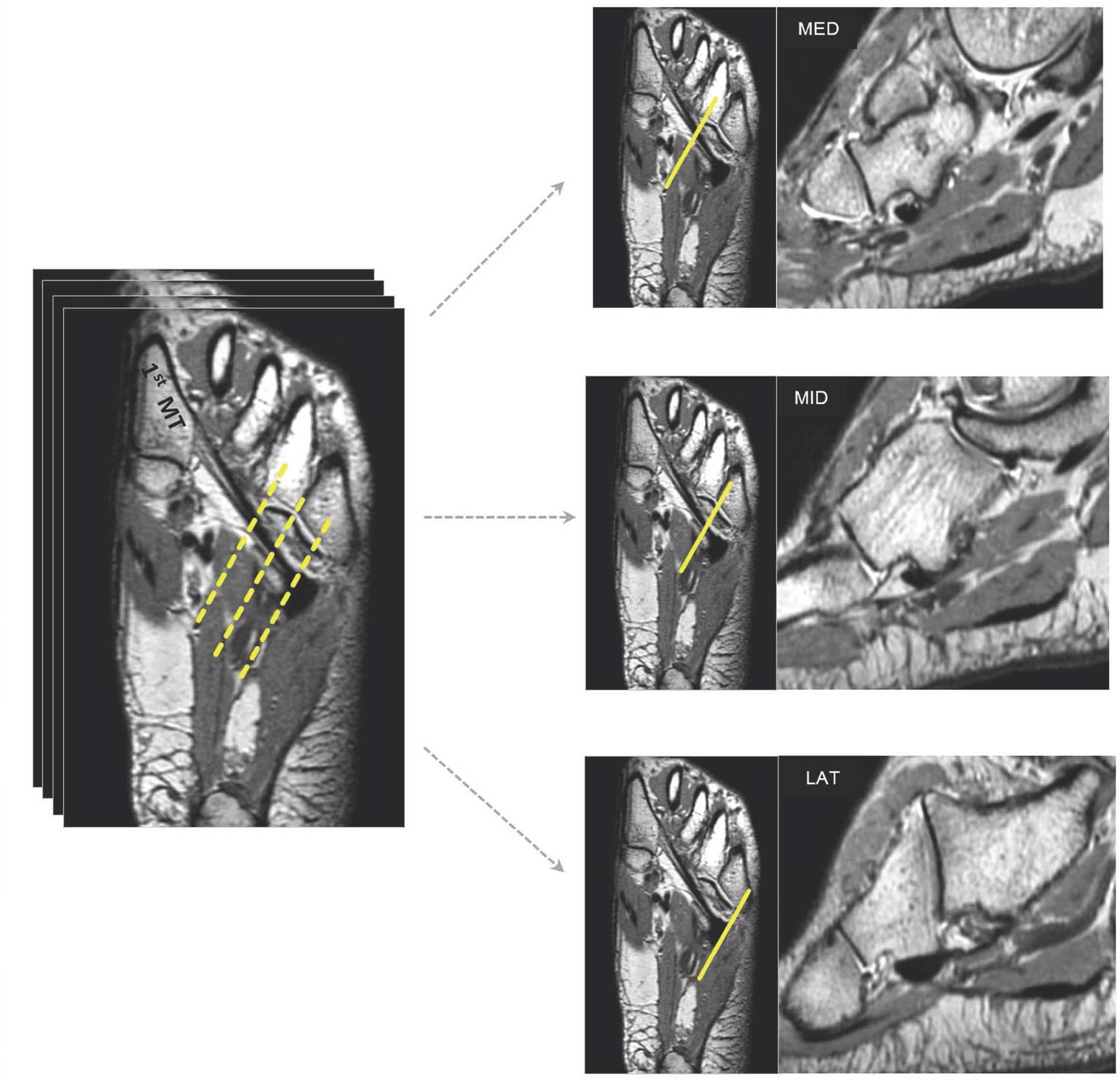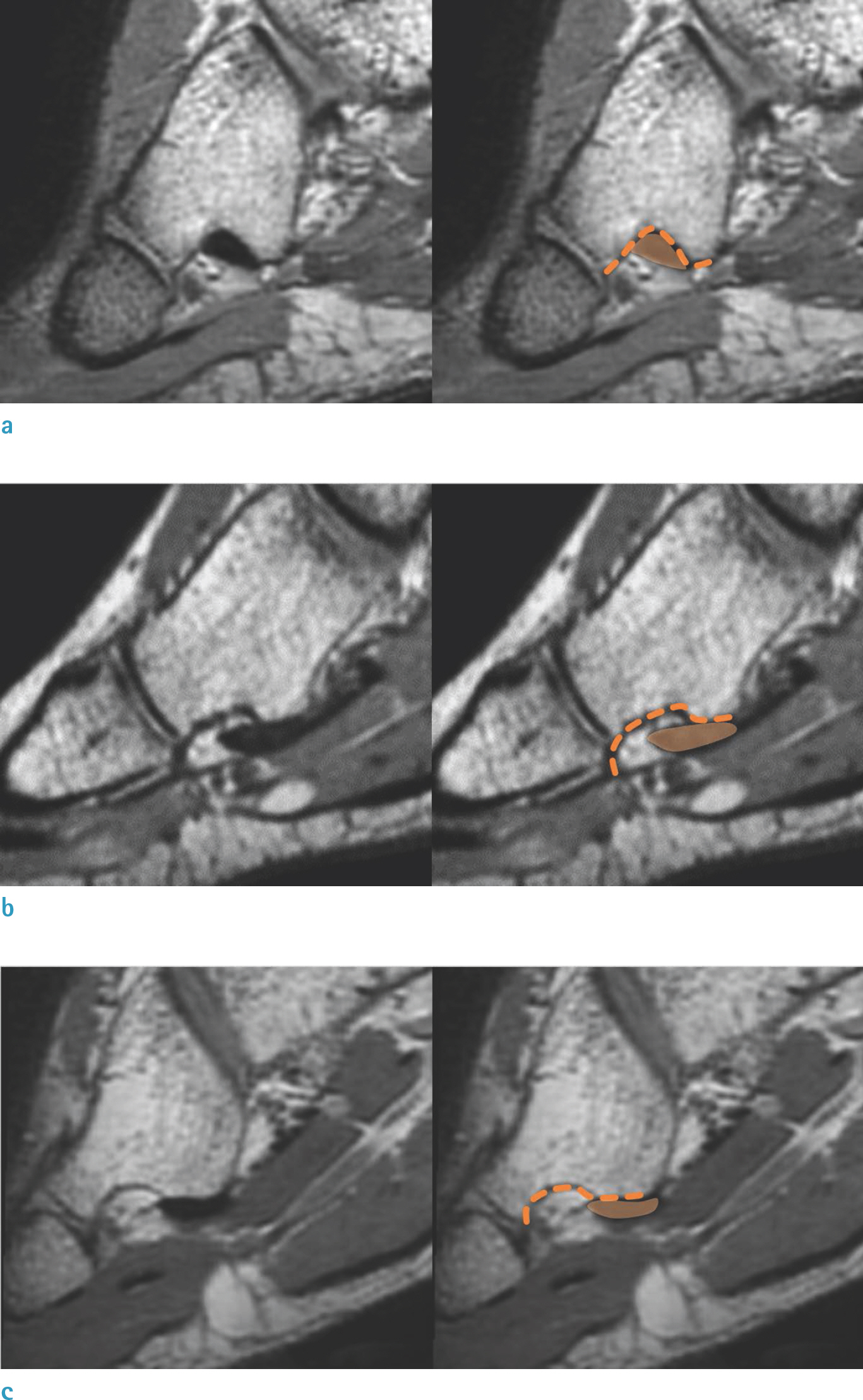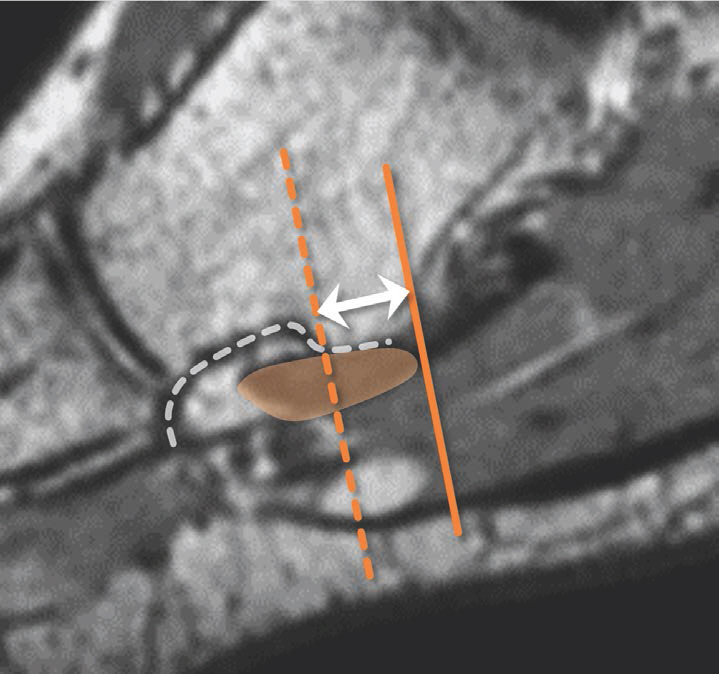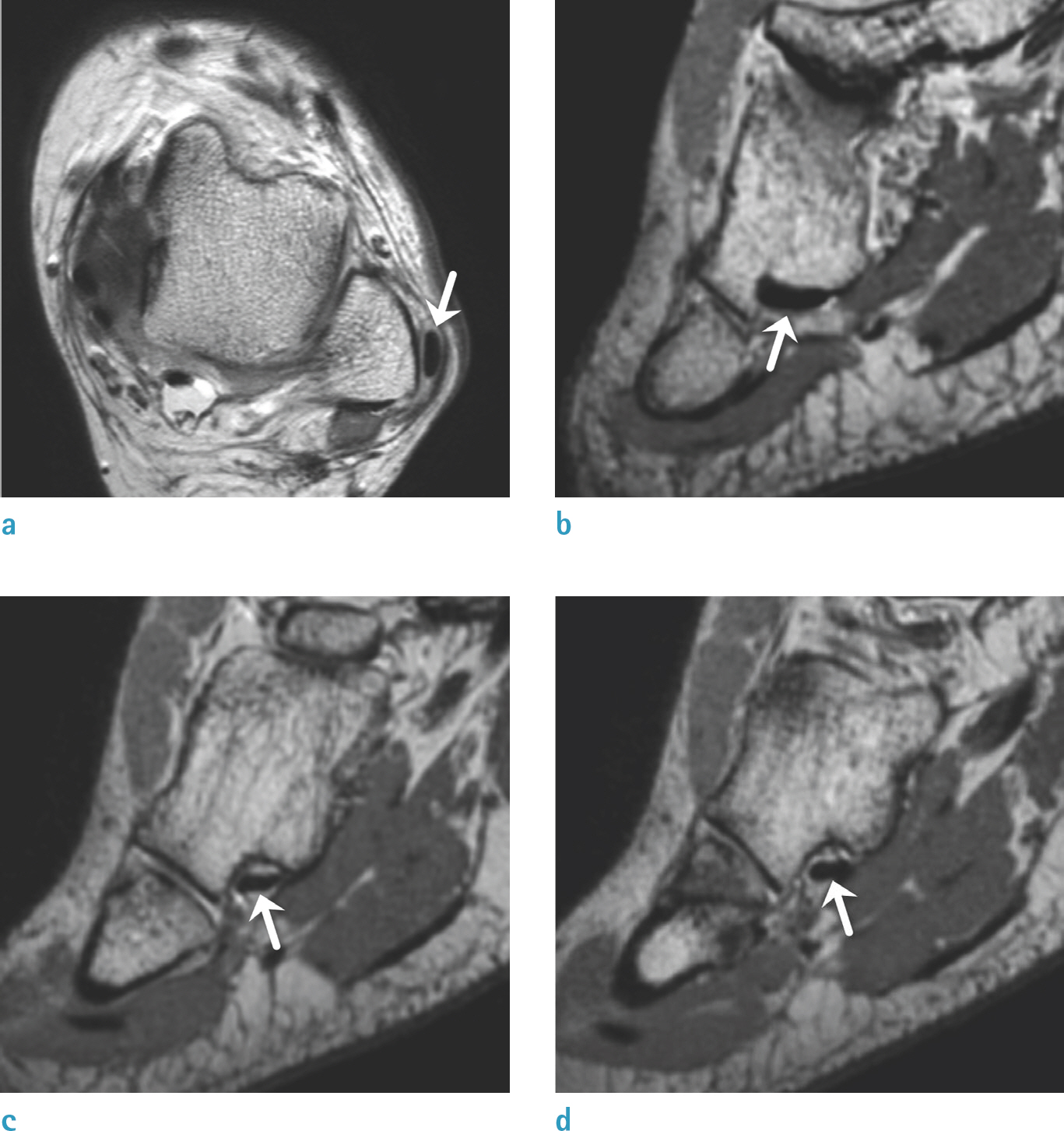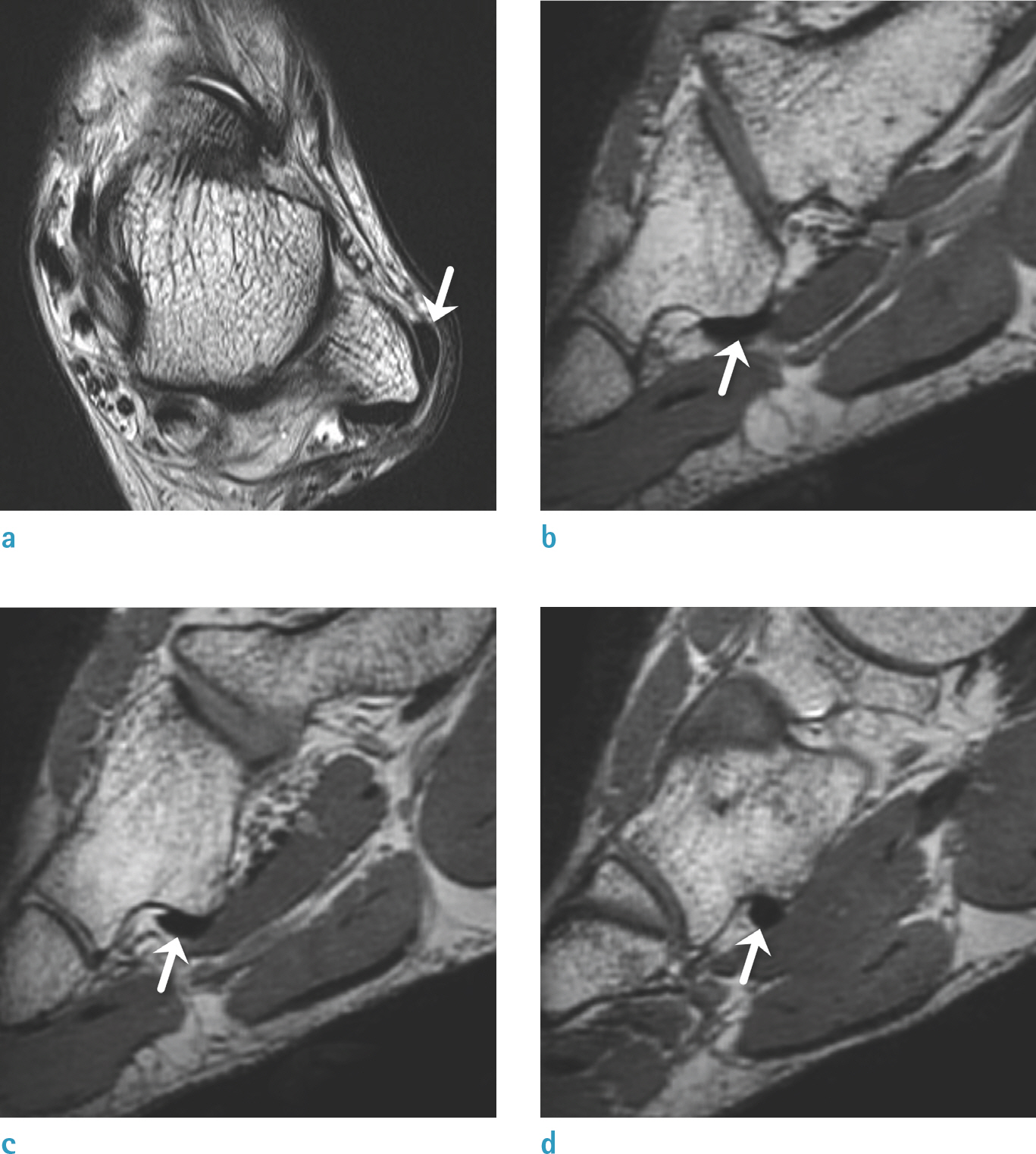Investig Magn Reson Imaging.
2020 Mar;24(1):21-29. 10.13104/imri.2020.24.1.21.
Assessment of the Location of the Peroneus Longus Tendon in the Cuboid Groove Using 3D Isotropic Fast Spin-Echo MRI
- Affiliations
-
- 1Department of Radiology, College of Medicine, Inje University, Busan Paik Hospital, Busan, Korea
- 2Department of Radiology, Seoul St. Mary’s Hospital, College of Medicine, The Catholic University of Korea, Seoul, Korea
- 3Department of Orthopedic Surgery, College of Medicine, Inje University, Busan Paik Hospital, Busan, Korea
- KMID: 2508214
- DOI: http://doi.org/10.13104/imri.2020.24.1.21
Abstract
- Purpose
To investigate normal location of the peroneus longus tendon (PL) in the cuboid groove by evaluating it between ankles with no significant abnormality (asymptomatic group) and those with retromalleolar PL dislocation (dislocation group) using three-dimensional isotropic fast spin-echo (3D-FSE) magnetic resonance imaging (MRI) of the ankle.
Materials and Methods
Thirty-six and 32 3D-FSE ankle MRI were assigned to the asymptomatic group and the dislocation group, respectively. Using multiplanar reformatted 3D-FSE, qualitative PL location (i.e., outside, overlying, and inside in relation to the cuboid groove), quantitative PL location (i.e., distance between the proximal margins of PL and cuboid groove), and cuboid groove size were measured in lateral, middle, and medial levels of the cuboid groove.
Results
In the asymptomatic group, 64%, 42%, and 11%, respectively, had the outside or overlying-located PL in lateral, middle, and medial levels of the cuboid groove and the quantitative location gradually decreased from lateral to medial level. Qualitative and quantitative PL locations were not significantly different between the asymptomatic group and dislocation group. Cuboid groove size showed significant negative correlation with quantitative PL location in both groups.
Conclusion
Outside- or overlying-located PL in lateral and middle levels of the cuboid groove would be a normal finding, regardless of PL status at the retromalleolar level.
Figure
Reference
-
1.Dombek MF., Lamm BM., Saltrick K., Mendicino RW., Catanzariti AR. Peroneal tendon tears: a retrospective review. J Foot Ankle Surg. 2003. 42:250–258.
Article2.Heckman DS., Gluck GS., Parekh SG. Tendon disorders of the foot and ankle, part 1: peroneal tendon disorders. Am J Sports Med. 2009. 37:614–625.3.Philbin TM., Landis GS., Smith B. Peroneal tendon injuries. J Am Acad Orthop Surg. 2009. 17:306–317.
Article4.Stone TJ., Rosenberg ZS., Velez ZR., Ciavarra G., Prost R., Bencardino JT. Subluxation of the peroneus long tendon in the cuboid tunnel: is it normal or pathologic? An ultrasound and magnetic resonance imaging study. Skeletal Radiol. 2016. 45:357–365.
Article5.Choo HJ., Lee SJ., Huang BK., Resnick DL. The location of the peroneus longus tendon in the cuboid groove: sonographic study in various positions of the ankle-foot in asymptomatic volunteers. Skeletal Radiol. 2018. 47:1277–1284.
Article6.Choo HJ., Lee SJ., Kim DW., Jeong HW., Gwak H. Multibanded anterior talofibular ligaments in normal ankles and sprained ankles using 3D isotropic proton density-weighted fast spin-echo MRI sequence. AJR Am J Roentgenol. 2014. 202:W87–94.
Article7.Stevens KJ., Busse RF., Han E, et al. Ankle: isotropic MR imaging with 3D-FSE-cube–initial experience in healthy volunteers. Radiology. 2008. 249:1026–1033.
Article8.Ulbrich EJ., Zubler V., Sutter R., Espinosa N., Pfirrmann CW., Zanetti M. Ligaments of the Lisfranc joint in MRI: 3D-SPACE (sampling perfection with application optimized contrasts using different flip-angle evolution) sequence compared to three orthogonal proton-density fat-saturated (PD fs) sequences. Skeletal Radiol. 2013. 42:399–409.
Article
- Full Text Links
- Actions
-
Cited
- CITED
-
- Close
- Share
- Similar articles
-
- Qualitative and Quantitative Assessment of Isotropic Ankle Magnetic Resonance Imaging: Three-Dimensional Isotropic Intermediate-Weighted Turbo Spin Echo versus Three-Dimensional Isotropic Fast Field Echo Sequences
- Fracture of the Os Peroneum with Rupture of the Peroneus Longus Tendon: A Case Report
- Surgical Treatment of Peroneus Longus Tendon Rupture after Ostectomy of Peroneus Tubercle of Calcaneus: A Case Report
- Peroneus Longus Dislocation associated with Trimalleolar Fracture: A Case Report
- Calcific Tendinitis of Peroneus Longus Tendon (A Case Report)

